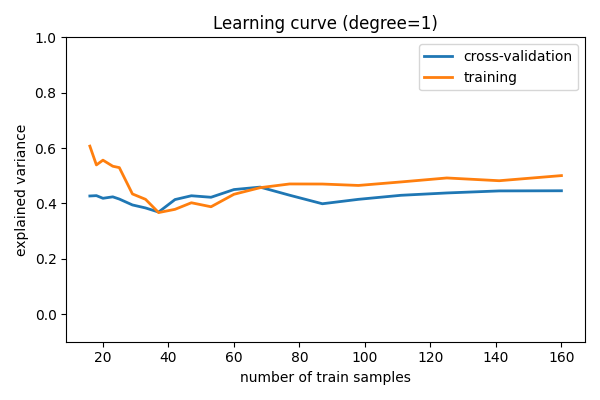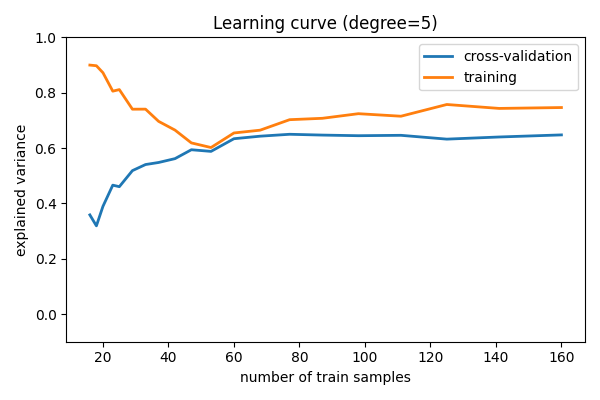注意
转到末尾 下载完整的示例代码。
3.4.8.16. 多项式拟合的偏差和方差¶
演示过拟合、欠拟合、以及验证和学习曲线与多项式回归。
用不同次数的多项式拟合数据集:对于次数过小的模型,模型欠拟合,而对于次数过大的模型,模型过拟合。
import numpy as np
import matplotlib.pyplot as plt
def generating_func(x, rng=None, error=0.5):
rng = np.random.default_rng(rng)
return rng.normal(10 - 1.0 / (x + 0.1), error)
多项式回归
from sklearn.pipeline import make_pipeline
from sklearn.linear_model import LinearRegression
from sklearn.preprocessing import PolynomialFeatures
一个简单的图来说明问题
n_samples = 8
rng = np.random.default_rng(27446968)
x = 10 ** np.linspace(-2, 0, n_samples)
y = generating_func(x, rng=rng)
x_test = np.linspace(-0.2, 1.2, 1000)
titles = ["d = 1 (under-fit; high bias)", "d = 2", "d = 6 (over-fit; high variance)"]
degrees = [1, 2, 6]
fig = plt.figure(figsize=(9, 3.5))
fig.subplots_adjust(left=0.06, right=0.98, bottom=0.15, top=0.85, wspace=0.05)
for i, d in enumerate(degrees):
ax = fig.add_subplot(131 + i, xticks=[], yticks=[])
ax.scatter(x, y, marker="x", c="k", s=50)
model = make_pipeline(PolynomialFeatures(d), LinearRegression())
model.fit(x[:, np.newaxis], y)
ax.plot(x_test, model.predict(x_test[:, np.newaxis]), "-b")
ax.set_xlim(-0.2, 1.2)
ax.set_ylim(0, 12)
ax.set_xlabel("house size")
if i == 0:
ax.set_ylabel("price")
ax.set_title(titles[i])
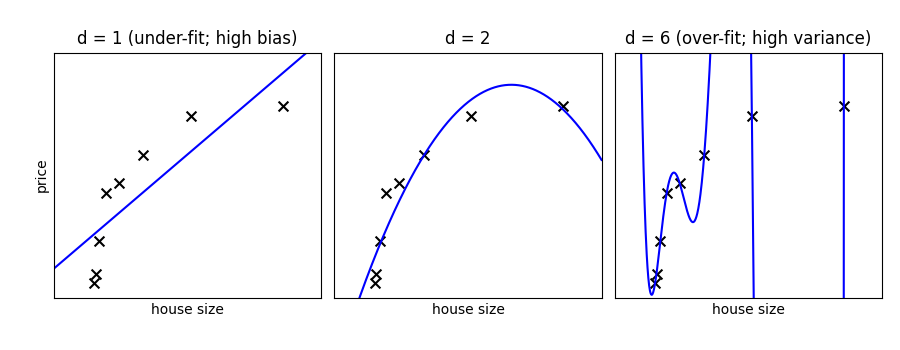
生成更大的数据集
from sklearn.model_selection import train_test_split
n_samples = 200
test_size = 0.4
error = 1.0
# randomly sample the data
x = rng.random(n_samples)
y = generating_func(x, rng=rng, error=error)
# split into training, validation, and testing sets.
x_train, x_test, y_train, y_test = train_test_split(x, y, test_size=test_size)
# show the training and validation sets
plt.figure(figsize=(6, 4))
plt.scatter(x_train, y_train, color="red", label="Training set")
plt.scatter(x_test, y_test, color="blue", label="Test set")
plt.title("The data")
plt.legend(loc="best")
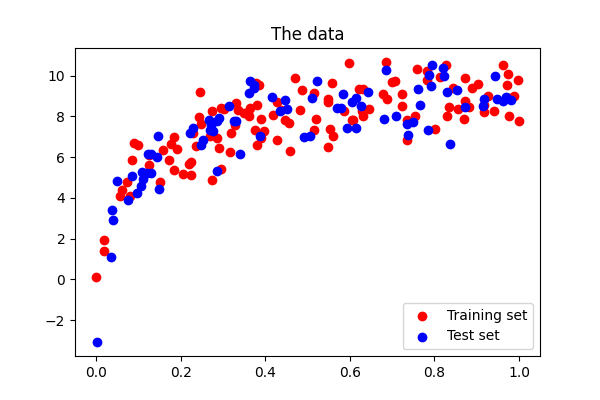
<matplotlib.legend.Legend object at 0x7f78e7283fb0>
绘制验证曲线
from sklearn.model_selection import validation_curve
degrees = list(range(1, 21))
model = make_pipeline(PolynomialFeatures(), LinearRegression())
# The parameter to vary is the "degrees" on the pipeline step
# "polynomialfeatures"
train_scores, validation_scores = validation_curve(
model,
x[:, np.newaxis],
y,
param_name="polynomialfeatures__degree",
param_range=degrees,
)
# Plot the mean train error and validation error across folds
plt.figure(figsize=(6, 4))
plt.plot(degrees, validation_scores.mean(axis=1), lw=2, label="cross-validation")
plt.plot(degrees, train_scores.mean(axis=1), lw=2, label="training")
plt.legend(loc="best")
plt.xlabel("degree of fit")
plt.ylabel("explained variance")
plt.title("Validation curve")
plt.tight_layout()
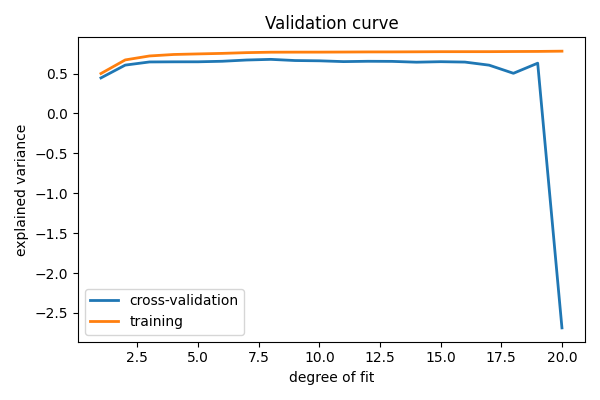
学习曲线¶
绘制随着样本数量增加的训练误差和测试误差
# A learning curve for d=1, 5, 15
for d in [1, 5, 15]:
model = make_pipeline(PolynomialFeatures(degree=d), LinearRegression())
from sklearn.model_selection import learning_curve
train_sizes, train_scores, validation_scores = learning_curve(
model, x[:, np.newaxis], y, train_sizes=np.logspace(-1, 0, 20)
)
# Plot the mean train error and validation error across folds
plt.figure(figsize=(6, 4))
plt.plot(
train_sizes, validation_scores.mean(axis=1), lw=2, label="cross-validation"
)
plt.plot(train_sizes, train_scores.mean(axis=1), lw=2, label="training")
plt.ylim(ymin=-0.1, ymax=1)
plt.legend(loc="best")
plt.xlabel("number of train samples")
plt.ylabel("explained variance")
plt.title("Learning curve (degree=%i)" % d)
plt.tight_layout()
plt.show()
脚本的总运行时间: (0 分钟 1.361 秒)
